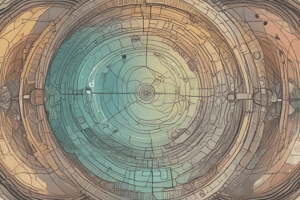Podcast
Questions and Answers
What is a crucial aspect to consider when transitioning between sections in interviews?
What is a crucial aspect to consider when transitioning between sections in interviews?
- Establishing rapport and obtaining valuable information (correct)
- Avoiding sensitive topics
- Maintaining objectivity throughout the interview
- Manipulating variables to achieve desired outcomes
What is the purpose of warm-up questions in an interview?
What is the purpose of warm-up questions in an interview?
- To establish the interviewer's authority
- To gather sensitive information
- To introduce the main topic of discussion
- To help respondents feel comfortable (correct)
What is an example of a structured question in an interview?
What is an example of a structured question in an interview?
- How did you feel about the recent election?
- Why were you opposed to the first Persian Gulf War?
- What do you think about the current economic situation?
- At what age did you start smoking? (correct)
What is an advantage of using interviews in research?
What is an advantage of using interviews in research?
What is a disadvantage of using interviews in research?
What is a disadvantage of using interviews in research?
What is the first step in developing an interview?
What is the first step in developing an interview?
What is the purpose of the 'ten commandments of interviewing'?
What is the purpose of the 'ten commandments of interviewing'?
What is an alternative method of survey research beyond interviews?
What is an alternative method of survey research beyond interviews?
What is the first step in conducting survey research?
What is the first step in conducting survey research?
What is the purpose of face-sheet information in an interview?
What is the purpose of face-sheet information in an interview?
What is the primary purpose of descriptive research?
What is the primary purpose of descriptive research?
Which type of research involves the manipulation of variables?
Which type of research involves the manipulation of variables?
What is the primary advantage of survey research?
What is the primary advantage of survey research?
What is the purpose of correlational studies?
What is the purpose of correlational studies?
What is an example of a survey research question?
What is an example of a survey research question?
What is the difference between descriptive and experimental research?
What is the difference between descriptive and experimental research?
What is the purpose of the Critical Thinking Questionnaire?
What is the purpose of the Critical Thinking Questionnaire?
What is the primary disadvantage of survey research?
What is the primary disadvantage of survey research?
What is the primary purpose of survey research?
What is the primary purpose of survey research?
What is a major advantage of survey research?
What is a major advantage of survey research?
What is a potential source of bias in survey research?
What is a potential source of bias in survey research?
What is the purpose of correlational research?
What is the purpose of correlational research?
What is the correlation coefficient used to measure?
What is the correlation coefficient used to measure?
What is an example of a positive correlation?
What is an example of a positive correlation?
What is important to note about correlations?
What is important to note about correlations?
What is the difference between a correlation of -0.61 and +0.21?
What is the difference between a correlation of -0.61 and +0.21?
What is the purpose of seeking confirmation from alternative sources in survey research?
What is the purpose of seeking confirmation from alternative sources in survey research?
What is an example of a study that uses correlational research?
What is an example of a study that uses correlational research?
What is the purpose of calculating the coefficient of determination?
What is the purpose of calculating the coefficient of determination?
What happens to the explained variance when the correlation coefficient increases from 0.4 to 0.5?
What happens to the explained variance when the correlation coefficient increases from 0.4 to 0.5?
What is the coefficient of alienation?
What is the coefficient of alienation?
What does Figure 9.2 illustrate?
What does Figure 9.2 illustrate?
What is the relationship between the correlation coefficient and the coefficient of determination?
What is the relationship between the correlation coefficient and the coefficient of determination?
What is the main difference between the correlation coefficient and the coefficient of determination?
What is the main difference between the correlation coefficient and the coefficient of determination?
What is the direction of the relationship indicated by in a correlation?
What is the direction of the relationship indicated by in a correlation?
What is the most common measure of the relationship between variables?
What is the most common measure of the relationship between variables?
What does a scattergram show?
What does a scattergram show?
What is the range of correlations?
What is the range of correlations?
What does a strong positive correlation indicate?
What does a strong positive correlation indicate?
What is the purpose of the Pearson correlation coefficient?
What is the purpose of the Pearson correlation coefficient?
What is the result of correlating a variable with itself?
What is the result of correlating a variable with itself?
Why is it important to interpret the Pearson correlation coefficient?
Why is it important to interpret the Pearson correlation coefficient?
What is the purpose of a correlation matrix?
What is the purpose of a correlation matrix?
What is the limitation of the eyeball method for interpreting the Pearson correlation coefficient?
What is the limitation of the eyeball method for interpreting the Pearson correlation coefficient?
What is the primary focus of descriptive research?
What is the primary focus of descriptive research?
What is the primary advantage of survey research?
What is the primary advantage of survey research?
What is the purpose of correlational studies?
What is the purpose of correlational studies?
What is an example of a survey research question?
What is an example of a survey research question?
What is the primary difference between descriptive and experimental research?
What is the primary difference between descriptive and experimental research?
What does a scattergram visually represent?
What does a scattergram visually represent?
What is the purpose of the Critical Thinking Questionnaire?
What is the purpose of the Critical Thinking Questionnaire?
What is a potential source of bias in survey research?
What is a potential source of bias in survey research?
What is the Pearson correlation coefficient used to measure?
What is the Pearson correlation coefficient used to measure?
What is the primary purpose of non-experimental research methods?
What is the primary purpose of non-experimental research methods?
What does a correlation of +1 indicate?
What does a correlation of +1 indicate?
What is the range of correlations?
What is the range of correlations?
What is the primary goal of descriptive research, as described in the chapter?
What is the primary goal of descriptive research, as described in the chapter?
What does a strong positive correlation indicate?
What does a strong positive correlation indicate?
What is the purpose of computing the Pearson correlation coefficient?
What is the purpose of computing the Pearson correlation coefficient?
What is the purpose of including neutral information, such as demographics, in an interview?
What is the purpose of including neutral information, such as demographics, in an interview?
What is a potential limitation of using unstructured questions in interviews?
What is a potential limitation of using unstructured questions in interviews?
What is a correlation matrix?
What is a correlation matrix?
Why is it important to rephrase questions in an interview if necessary?
Why is it important to rephrase questions in an interview if necessary?
What does a negative correlation indicate?
What does a negative correlation indicate?
What is a benefit of using mail questionnaires in survey research?
What is a benefit of using mail questionnaires in survey research?
What is the primary purpose of the literature review in developing an interview?
What is the primary purpose of the literature review in developing an interview?
What is a key consideration when conducting survey research?
What is a key consideration when conducting survey research?
What is the purpose of conducting field testing in the development of an interview?
What is the purpose of conducting field testing in the development of an interview?
What is the primary purpose of survey research?
What is the primary purpose of survey research?
What is a major challenge in collecting survey data?
What is a major challenge in collecting survey data?
What does a correlational study aim to do?
What does a correlational study aim to do?
What is the correlation coefficient used to measure?
What is the correlation coefficient used to measure?
What is an example of a positive correlation?
What is an example of a positive correlation?
What is important to note about correlations?
What is important to note about correlations?
What is the purpose of seeking confirmation from alternative sources in survey research?
What is the purpose of seeking confirmation from alternative sources in survey research?
What is the difference between a correlation of -0.61 and +0.21?
What is the difference between a correlation of -0.61 and +0.21?
What is the purpose of calculating the coefficient of determination?
What is the purpose of calculating the coefficient of determination?
What happens to the explained variance when the correlation coefficient increases from 0.4 to 0.7?
What happens to the explained variance when the correlation coefficient increases from 0.4 to 0.7?
What is the coefficient of alienation?
What is the coefficient of alienation?
What is the relationship between the correlation coefficient and the coefficient of determination?
What is the relationship between the correlation coefficient and the coefficient of determination?
What does Figure 9.2 illustrate?
What does Figure 9.2 illustrate?
What is the advantage of using the coefficient of determination?
What is the advantage of using the coefficient of determination?
What is the result of increasing the correlation coefficient from 0.4 to 0.5?
What is the result of increasing the correlation coefficient from 0.4 to 0.5?
What is the characteristic of the relationship between the correlation coefficient and the amount of variance explained?
What is the characteristic of the relationship between the correlation coefficient and the amount of variance explained?
Flashcards are hidden until you start studying
Study Notes
Survey Research Methods
- Definition: Survey research is a type of descriptive research that aims to describe current phenomena without manipulating variables.
- Purpose: To understand and describe current phenomena, attitudes, beliefs, and opinions.
Types of Survey Research
- Correlational Studies: Describe relationships between variables without inferring causation.
- Interviews:
- Types:
- Structured Questions: Clear, closed-ended questions with explicit answers.
- Unstructured Questions: Open-ended questions allowing for broad responses.
- Advantages:
- Flexibility
- Observation of nonverbal behavior
- Control over the tone and agenda
- Disadvantages:
- Time-consuming
- Potential bias
- Lack of standardization
- Types:
Conducting Interviews
- Steps:
- Purpose and Goals: Define the interview's purpose and desired outcomes.
- Literature Review: Review existing literature and previous interviews in the field.
- Sample Selection: Choose a diverse and representative sample.
- Question Development: Create clear and concise questions, avoiding hidden agendas.
- Field Testing: Test the interview with a similar audience and adjust based on feedback.
- Interviewer Training: Train interviewers to be polite, attentive, and proactive.
- Conducting Interviews: Allocate sufficient time and be assertive but respectful during interviews.
Correlational Research
- Definition: A type of descriptive research that looks at the linear relationship between two or more variables without suggesting that one variable affects the other.
- Purpose: To understand relationships between variables.
- Examples:
- Relationship between multiple intelligences and metacognitive strategies in MA students of TEFL.
- Relationship among meta-memory, meta-cognitive vocabulary, and the role of theory of mind in Persian young children.
Correlation Coefficients
- Definition: A numerical index that shows the strength of the relationship between two variables.
- Types:
- Positive Correlation: As one variable increases, the other also increases.
- Negative Correlation: As one variable increases, the other decreases.
- Important Points:
- Correlations are not causal.
- The strength of a correlation is measured by its absolute value, not its sign.
Scattergrams
- Definition: A visual representation of the correlation coefficient between two variables, showing scores in pairs.
- Purpose: To visualize the relationship between two variables.
Interpreting Correlation Coefficients
- Methods:
- Eyeball Method: Associating certain correlation values with a degree of relationship.
- Coefficient of Determination: Squaring the correlation coefficient to show how much of the variance in one variable can be explained by the variance in another variable.
Survey Research Methods
- Definition: Survey research is a type of descriptive research that aims to describe current phenomena without manipulating variables.
- Purpose: To understand and describe current phenomena, attitudes, beliefs, and opinions.
Types of Survey Research
- Correlational Studies: Describe relationships between variables without inferring causation.
- Interviews:
- Types:
- Structured Questions: Clear, closed-ended questions with explicit answers.
- Unstructured Questions: Open-ended questions allowing for broad responses.
- Advantages:
- Flexibility
- Observation of nonverbal behavior
- Control over the tone and agenda
- Disadvantages:
- Time-consuming
- Potential bias
- Lack of standardization
- Types:
Conducting Interviews
- Steps:
- Purpose and Goals: Define the interview's purpose and desired outcomes.
- Literature Review: Review existing literature and previous interviews in the field.
- Sample Selection: Choose a diverse and representative sample.
- Question Development: Create clear and concise questions, avoiding hidden agendas.
- Field Testing: Test the interview with a similar audience and adjust based on feedback.
- Interviewer Training: Train interviewers to be polite, attentive, and proactive.
- Conducting Interviews: Allocate sufficient time and be assertive but respectful during interviews.
Correlational Research
- Definition: A type of descriptive research that looks at the linear relationship between two or more variables without suggesting that one variable affects the other.
- Purpose: To understand relationships between variables.
- Examples:
- Relationship between multiple intelligences and metacognitive strategies in MA students of TEFL.
- Relationship among meta-memory, meta-cognitive vocabulary, and the role of theory of mind in Persian young children.
Correlation Coefficients
- Definition: A numerical index that shows the strength of the relationship between two variables.
- Types:
- Positive Correlation: As one variable increases, the other also increases.
- Negative Correlation: As one variable increases, the other decreases.
- Important Points:
- Correlations are not causal.
- The strength of a correlation is measured by its absolute value, not its sign.
Scattergrams
- Definition: A visual representation of the correlation coefficient between two variables, showing scores in pairs.
- Purpose: To visualize the relationship between two variables.
Interpreting Correlation Coefficients
- Methods:
- Eyeball Method: Associating certain correlation values with a degree of relationship.
- Coefficient of Determination: Squaring the correlation coefficient to show how much of the variance in one variable can be explained by the variance in another variable.
Studying That Suits You
Use AI to generate personalized quizzes and flashcards to suit your learning preferences.




